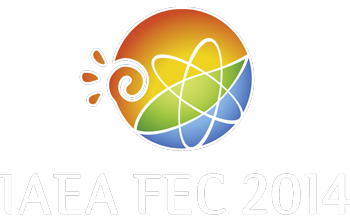Speaker
Dr
Sterling Smith
(USA)
Description
Optimization and control of the H-mode pedestal and scrape-off layer (SOL) for burning plasma devices such as ITER requires a predictive model for the transport of particles, energy and momentum from the top of the pedestal to the first wall. The transport simulation code XGC0 leverages high-performance computing to rigorously compute the full-f multi-species (D+, C6+, e-) flux-driven neoclassical transport with self-consistent neutral recycling and model-based anomalous transport in the H-mode pedestal and SOL. Net particle transport and electron thermal transport is anomalous, while ion thermal and momentum transport is predominately neoclassical in the steep-gradient region of the pedestal. The separate transport mechanisms resolves the decoupling of energy and particle transport often observed in the evolution of the H-mode barrier or in regimes with enhanced particle transport from an edge mode, such as QH-mode or I-mode. It is shown that the radial electric field (Er) in the pedestal is the root solution that balances ion orbit loss of high-energy counter-Ip ions against a pinch of colder ions. Neoclassical effects lead to non-Maxwellian ion energy distributions that manifest as intrinsic co-Ip parallel flows, Ti anisotropy (Tθ ≠ Tϕ) and non-monotonic Zeff profiles, especially at low collisionality. These effects are quantitatively demonstrated through comparisons of XGC0 simulations to a low-collisionality QH-mode pedestal and a zero-torque intrinsically rotating ECH-heated discharge on DIII-D. EPH-mode on NSTX is a stationary ELM-free regime that has a double barrier in the ion thermal transport and a single barrier in the particle transport. XGC0 simulations indicate that the enhanced thermal ion confinement occurs when the parallel rotational shear length is on the order of ion orbit, improving the confinement of tail ions and reinforcing the rotational shear. The neoclassical origin of Er results in a predictable connection between the E×B flow shear and magnetic geometry that can be leveraged to control the requirements for the L-H transition. For example, experiment and simulation demonstrate that a lower edge Ti is required to enter H-mode as the X-point increases to a low-triangularity shape on NSTX.
This work was supported by the US Department of Energy under DE-AC02-09CH11466, DE-FG02-07ER54917, DE-FC02-04ER54698, and DE-AC05-00OR22725.
| Country or International Organisation | USA |
|---|---|
| Paper Number | EX/P2-24 |
Author
Dr
Devon Battaglia
(Princeton Plasma Physics Laboratory, USA)
Co-authors
Mr
B.A. Grierson
(Princeton Plasma Physics Laboratory)
Dr
Choong-Seock Chang
(Princeton Plasma Physics Laboratory and KAIST)
John Canik
(Oak Ridge National Laboratory)
Dr
John S. deGrassie
(General Atomics)
Dr
Jose A. Boedo
(University of California San Diego)
Dr
Keith H. Burrell
(General Atomics)
Mr
R.J. Groebner
(General Atomics)
Dr
Rajesh Maingi
(Oak Ridge National Laboratory)
Dr
Stefan Gerhardt
(Princeton Plasma Physics Laboratory)
Dr
Sterling Smith
(USA)

